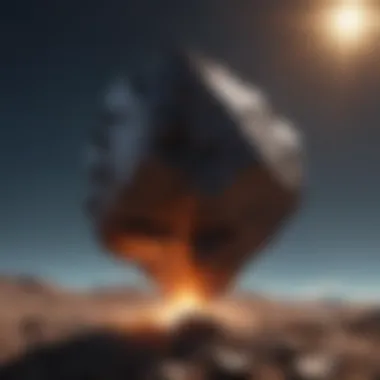Exploring Meteorites: Origins and Significance Unveiled


Intro
Meteorites, the remnants of celestial bodies from space, have sparked human curiosity for centuries. They provide essential clues about the formation and evolution of our solar system. This article will explore their origins, classification, and significance, highlighting their role in enhancing our understanding of both the cosmos and Earth's geological history.
History and Origins
Overview of Collectibles, Rocks, and Fossils
Meteorites are among the most esteemed collectibles for rock and fossil enthusiasts. Their distinct characteristics, such as unique textures and chemical compositions, make them a fascinating area of study. Unlike ordinary terrestrial rocks, meteorites have traversed the void of space, often originating from asteroids or even other celestial bodies like the Moon and Mars. Collectors are drawn to the story each meteorite carries, reflecting the conditions and environments from which they came.
Historical Significance and Cultural Impact
The fascination with meteorites spans cultures and epochs. Ancient civilizations like the Greeks and Chinese recorded sightings of meteor showers and the unique stones that fell to Earth. Many viewed these objects as harbingers of change or omens. In modern times, meteorites have become essential to our understanding of planetary science.
The circumstances surrounding a meteorite's fall can offer insights into the nature of the solar system's building blocks. Every discovery adds depth to the narrative of our planet's origins.
"Meteorites are time capsules, offering a window into the history of our solar system and the elements that compose it."
Identification and Classification
Guide to Identifying Rocks and Fossils
Identifying meteorites requires a keen eye. Most meteorites exhibit a distinctive fusion crust, formed when they burn upon entering Earth's atmosphere. Other notable traits include metallic flecks and osmium-rich minerals, often unseen in common terrestrial rocks. The presence of chondrules—small, round particles found in certain meteorites—further designates them as remnants of early solar system material.
Common Types and Variations
Meteorites are classified into several categories based on their chemical and physical properties:
- Chondrites: The most common type, rich in spherical structures called chondrules, providing critical information about the early solar system.
- Achondrites: Formed from differentiated bodies, often containing igneous rock that reveals volcanic activity on their parent bodies.
- Iron Meteorites: Composed largely of metallic iron and nickel, these are remnants of the cores of larger asteroids.
- Stony-Iron Meteorites: A mix of metal and silicate minerals, representing material from the transition zone between metal-rich cores and silicate mantles.
Understanding these classifications aids both collectors and scientists in appreciating the diverse origins of meteorites and their impact on our natural world.
Foreword to Meteorites
Meteorites serve as invaluable pieces of evidence when studying the origins and evolution of our solar system. Their journey from space to Earth is both fascinating and complex, presenting a myriad of opportunities for research and discovery. Understanding meteorites is important because they offer clues about the formation of celestial bodies, including planets and asteroids. They provide a direct link to the building blocks of our universe, allowing scientists and collectors alike to gain insights into planetary processes and history.
Definition and Characteristics
A meteorite is defined as a solid fragment that survives its passage through the Earth's atmosphere and lands on the surface. These objects originate from various celestial bodies and can vary significantly in their composition, size, and appearance. Their physical characteristics often depend on their original source. For instance, stony meteorites are primarily made of silicate minerals, while iron meteorites are primarily composed of metallic iron. Some meteorites show unique textures or structures, which can reveal information about their cooling history and the conditions under which they formed. Their study is essential not only for scientific purposes but also for enhancing our understanding of natural history.
Historical Significance
The historical significance of meteorites extends far beyond their scientific value. Since ancient times, meteorites have been objects of fascination and reverence. They have inspired myths, religious beliefs, and explorations. Various cultures have documented meteorite falls, interpreting them as omens or divine messages. The study of meteorites can provide insight into early human understanding of the cosmos and the evolution of scientific thought. This historical dimension offers context for today’s scientific pursuits, underscoring how our relationship with these celestial objects has evolved over time.
"Meteorites have been a part of human history for millennia, linking our past with the vastness of space."
In summary, the exploration of meteorites is essential for unraveling the mysteries of our solar system. Each meteorite holds clues to its origins and the processes that shaped it. Through careful study, collectors and scientists can gain insights that contribute to a deeper understanding of the universe.
Formation of Meteorites
The formation of meteorites is a critical area of study within the realm of astrophysics and planetary science. Understanding where meteorites come from and how they are formed can provide valuable insights into the early solar system and the materials that made up the planets. Meteorites are essentially time capsules, preserving ancient materials that can reveal information about the conditions and processes occurring in space millions or even billions of years ago.
Cosmic Origins
Meteorites originate from various celestial bodies, primarily asteroids and comets. This cosmic journey begins when these bodies experience disruptions, such as collisional impacts, that can break off pieces of their mass. These fragments then travel through space, occasionally entering Earth's atmosphere. The study of cosmic origins emphasizes how these materials serve as remnants of the early solar system.
Asteroids, particularly those in the asteroid belt between Mars and Jupiter, are often the primary source. They contain primordial matter that has been largely unchanged since the system's formation. When fragments from these bodies reach Earth, they provide unique opportunities for research into the basic building blocks of planetary systems.
Comets also play a significant role in meteorite formation. They carry water and organic compounds, remnants from the outer solar system. When comets undergo close encounters with the sun, they can shed material, some of which may eventually collide with Earth as meteorites.
"Meteorites offer a glimpse into the materials that formed our planets and reveal critical information about our cosmic history."
Role of Asteroids and Comets
Asteroids and comets are fundamental contributors to the population of meteorites that reach our planet. The role of asteroids is multifaceted. Most asteroids are remnants from the solar system's formation. As they orbit the sun, gravitational forces can artificially alter their paths, often resulting in collisions that eject material into space. The larger the asteroid, the more potential it has for producing substantial pieces that can become meteorites. Iron and stony-iron meteorites are commonly associated with these origins, exhibiting properties gleaned from their parent bodies.


Comets differ in composition and behavior from asteroids. Composed mainly of ice and dust, they are often found in the outer regions of the solar system. When comets travel closer to the sun, they heat up and release gas and dust, which can precipitate meteor showers. When particles detach from the comet, they may become meteorites upon reaching Earth.
The interactions between asteroids, comets, and Earth are crucial to understanding not only the origin of meteorites but also the broader evolution of our solar system. Knowledge about these interactions enriches our comprehension of planetary formation processes. Additionally, the study of meteorites derived from both asteroids and comets is closely linked to theories concerning the delivery of water and organic materials to Earth, which may have been crucial to the emergence of life.
In summary, the formation of meteorites is an astoundingly rich field worthy of detailed exploration. Their origins provide profound insights into our cosmic heritage and help illuminate aspects of planetary science crucial for collectors and scholars alike.
Types of Meteorites
Understanding the types of meteorites is crucial for several reasons. First, each type provides insight into the processes that shape celestial bodies and our solar system. Second, categorizing meteorites helps scientists communicate findings effectively. Moreover, collectors benefit from knowing the distinctions between types, which influences both value and significance in research. This section elaborates on three primary types of meteorites: stony, iron, and stony-iron.
Stony Meteorites
Stony meteorites are, in fact, the most common type found on Earth. They make up about 93% of all known meteorites. These meteorites consist mainly of silicate minerals. Among stony meteorites, there are two subcategories: chondrites and achondrites.
Chondrites are particularly noteworthy as they are believed to be the building blocks of planets. They contain small spherical inclusions called chondrules, which formed in the solar nebula. Achondrites, on the other hand, lack these structures and are often associated with differentiated bodies, such as asteroids that underwent volcanic action.
The study of stony meteorites reveals significant information about the early solar system. Analyzing their chemical and isotopic composition can offer glimpses into the conditions under which they formed.
Iron Meteorites
Iron meteorites are primarily composed of iron and nickel. They represent about 6% of meteorite finds. Their distinctive metallic nature causes them to be highly sought after by collectors. Iron meteorites often originate from the cores of differentiated asteroids. This means they come from the heart of these celestial bodies, which were once molten.
The classification of iron meteorites is primarily based on their structure. The Widmanstätten pattern is a feature unique to these meteorites. It showcases a beautiful interlacing pattern observable when polished. This feature provides valuable insights into the cooling history of iron meteorites, which can be hundreds of millions of years old.
Research into iron meteorites offers significant information regarding planetary formation and the conditions within the early solar system. They also serve as a reminder of the dynamic processes that occur in space.
Stony-Iron Meteorites
Stony-iron meteorites are a rare combination containing both silicate minerals and metallic iron-nickel. Making up less than 2% of meteorite finds, they are intriguing to both scientists and collectors. This type typically forms at the boundary between the metallic core and the silicate mantle of differentiated asteroids.
These meteorites are further divided into two main categories: pallasites and mesosiderites. Pallasites are often recognized for their olivine crystals suspended within a metallic matrix. Mesosiderites, in contrast, exhibit characteristics of both stony and iron meteorites and have a mixed composition.
The study of stony-iron meteorites provides valuable information about the processes of differentiation and the history of their parent bodies. They can inform us about the dynamic and complex processes at play during the formation of the solar system.
"Meteorites serve as tangible links to our cosmic origins, each type telling a part of the story of the universe's creation and evolution."
Meteorite Classification
Meteorite classification is crucial for understanding the diverse range of meteorites that fall to Earth. The classification process helps scientists and collectors to systematically categorize meteorites based on their physical and chemical properties. This organization plays a significant role in advancing our knowledge about their origins, composition, and the processes that formed them. By grouping meteorites into specific categories, researchers can compare samples and draw conclusions about the early solar system, planetary formation, and geological history.
Chemical Composition
Meteorites can be classified by analyzing their chemical composition. Each type of meteorite—stony, iron, and stony-iron—has distinct elemental makeups that reveal information about their origins. For example, stony meteorites, which are the most common type, primarily consist of silicate minerals such as olivine and pyroxene. Iron meteorites, on the other hand, mainly contain iron and nickel, often reflecting their formation from the metallic cores of differentiated asteroids.
Furthermore, isotopic analysis provides deeper insights into the age and development of these materials. Specific isotopic ratios can indicate the conditions under which the meteorite formed. Recognizing these chemical signatures can lead to significant discoveries about the building blocks of our solar system.
Mineral Structure
The mineral structure of meteorites is essential for classification and understanding their formation. Meteorites possess unique textures and crystalline arrangements that reflect their histories. For instance, chondrites exhibit chondrules—small, round particles—that are significant for deciphering their origins. These structures help scientists to infer the conditions and processes in the early solar nebula.
In contrast, the crystalline patterns found in eucentric meteorites indicate a different evolutionary pathway. Their textures often show a history of cooling and crystallization processes that provide clues about their parent bodies. Thus, examining their mineral structures is vital for deriving a more comprehensive picture of solar system formation.
Geological Context
The geological context of meteorites is a key factor in classification. Meteorites are not just random rocks from space; they have specific origins that link them to particular parent bodies, such as asteroids and planets. This information is critical for understanding the processes that shaped our solar system. For instance, the distribution of meteorite types can highlight the varying conditions of different parent bodies.
In many cases, meteoric impacts on Earth can be tracked through their geological context, providing insights into historical events on our planet. For example, the Chicxulub impact, associated with the extinction of the dinosaurs, can be studied through meteorite finds, contributing to our knowledge of mass extinctions.
In summary, meteorite classification is integral to our understanding of these celestial objects. Through chemical composition, mineral structure, and geological context, significant insights emerge about the origins and evolution of the solar system. This classification system ultimately aids researchers in piecing together the complex history of our planetary neighborhood.
Meteorite Recovery and Collection
Meteorite recovery and collection is a crucial aspect of studying these celestial objects. For collectors and scientists alike, understanding how to find and preserve meteorites enhances their appreciation of these rare specimens. The significance of this topic extends beyond mere hobbyist interest; it also contributes to scientific knowledge and ethical practices within the field.
In the context of this article, it is important to emphasize the multifaceted nature of meteorite recovery. The benefits of recovering meteorites range from expanding our knowledge of the solar system to allowing for tangible connections to our cosmic origins. Furthermore, collectors can gain a sense of purpose and community through shared experiences and knowledge in this niche field. Understanding how meteorites are recovered and collected brings about responsible practices that respect both scientific integrity and legal boundaries.


Meteorite Hunting Techniques
Meteorite hunting requires specific techniques and approaches. Budding hunters need to be prepared, as the success of a hunt often depends on methodical planning. Different environments can yield different types of meteorites. Here are some foundational techniques for effective meteorite hunting:
- Research Locations: Look into regions known for meteorite falls. For example, areas like the Sahara Desert or Antarctic ice are hotspots.
- Observation Tools: Using metal detectors can enhance the chances of finding iron-rich meteorites. Additionally, binoculars or telescopes might help spot recent falls or significant markers.
- Ground Searching: Physical searching involves scanning the ground. Dark-colored meteorites can be easier to spot against lighter soil or rocks.
- Networking: Engaging with local collector groups can yield tips and previously documented meteorite locations. Online forums, such as those on Reddit, can also provide insights into recent finds and techniques.
Effective meteorite hunting takes dedication and often a fair amount of luck. Each recovery contributes not only to personal collections but also to the scientific community’s understanding of these interstellar objects.
Legal and Ethical Considerations
The legal and ethical dimensions of meteorite recovery cannot be overlooked. Understanding the regulations surrounding meteorite collection is essential. This is particularly true when operating in foreign countries or protected areas. Key considerations include:
- Ownership Laws: Different countries have varying laws regarding the ownership of recovered meteorites. Familiarizing oneself with local regulations is crucial.
- Respect for Indigenous Lands: Many meteorite finds occur on lands that may be sensitive or have cultural significance to indigenous peoples. Collectors must approach these areas with respect and seek permission where necessary.
- Scientific Sharing: Engaging with the scientific community can lead to more reliable data sharing. Many researchers encourage amateur hunters to report findings, enhancing overall knowledge.
The ethical aspects of meteorite collection remind us that we are not just collectors; we are stewards of history and science.
By adhering to these legal and ethical guidelines, collectors can ensure that they not only enrich their own pursuits but also contribute positively to the broader understanding of meteorites and their significance in our natural world.
Scientific Importance of Meteorites
Meteorites hold substantial scientific value, providing a direct link to the early solar system. These celestial objects are remnants from the formation of planets, offering clues about the historical processes that shaped their development. By studying meteorites, scientists can derive insights that are not only relevant to planetary science but also contribute to our understanding of life's origins.
Research on meteorites is crucial for multiple reasons. First, they are among the few natural samples available from space, allowing direct analysis rather than relying solely on theoretical models. Second, their age and composition can function as benchmarks in cosmochemistry. This understanding aids researchers in piecing together the cosmic history that led to the formation of our solar system.
Meteorites also provide a unique opportunity for interdisciplinary collaboration. Geologists, chemists, and astrophysicists often work together to analyze these specimens. This collective effort enhances our grasp of not just the meteorites themselves but also the broader context of planetary systems and stellar evolution.
"Understanding meteoritics means grasping the building blocks of our planet's birth, and by extension, our own existence."
Insights into Solar System Formation
The study of meteorites yields significant insights into the formation of the solar system. Many meteorites are remnants from the early solar system, offering a snapshot of conditions that existed over 4.5 billion years ago. Analysis of isotopic ratios and chemical composition reveals details about the solar nebula, the cloud of gas and dust that collapsed to form the sun and planets.
Stony meteorites, for example, often contain minerals that crystallized from molten rock. Their textures and mineral assemblages can indicate thermal history and differentiation processes in small bodies. Through these studies, scientists can reconstruct the timeline of solar system formation.
Understanding this timeline is paramount. It helps answer questions about how the planets formed, the processes that led to the current architecture of the solar system, and the conditions that existed during its infancy. In turn, these findings contribute to broader space exploration goals, such as identifying potential future missions to asteroids.
Connecting to Planetary Science
Meteorites not only illuminate the history of our solar system but also connect directly to the field of planetary science. The comparative study of meteorites and planetary bodies allows scientists to learn about the processes that govern planetary evolution. Each type of meteorite reflects different environments and conditions encountered in space.
Research focuses on how meteorites relate to specific celestial bodies. For instance, iron meteorites are believed to originate from the cores of differentiated asteroids, mirroring the internal structures of terrestrial planets. This correlation aids in understanding the evolution of planetary cores and crusts.
Moreover, meteorites serve as proxies for examining planetary atmospheres and conditions that may be suitable for life. Organic compounds found in certain meteorites strengthen the link between meteorite studies and astrobiology. Understanding the ingredients that compose meteorites guides inquiries into the building blocks of life elsewhere in the universe.
The integration of findings from meteorites into planetary science research sparks fresh questions about the processes and histories of not only our own planet but also those beyond.
- Meteorite studies contribute to:
- Understanding solar system formation
- Insights into planetary evolution
- Clarity on potential extraterrestrial life
Modern Research and Analysis
Modern research and analysis play a crucial role in understanding meteorites, offering insights that enhance our general knowledge about these celestial objects. The study of meteorites not only unravels the history of our solar system but also aids in various scientific investigations, including planetary formation and the materials present in other celestial bodies. Furthermore, the advancements in research methodologies have improved our ability to analyze meteorite samples more effectively, which contributes to academic research and satisfies the curiosity of collectors and enthusiasts alike.
Meteorite Studies in Laboratories
Laboratory studies of meteorites have significantly advanced in recent years. Scientists employ various techniques to investigate the physical and chemical properties of meteorites. These analyses allow for a better understanding of the solar system's history. For instance, isotopic analysis can reveal the age of meteorites, which in turn provides insights into the early solar system. Some methodologies involve:
- Scanning Electron Microscopy (SEM): This technique allows for high-resolution imaging of meteorite samples to understand their mineralogy.
- Mass Spectrometry: Used to study isotopes, this method helps determine the elemental composition of mineral phases in meteorites.
- X-ray Diffraction: This assists in identifying the crystalline structure of minerals present in the meteorites.
Such studies are essential for cataloging findings and establishing connections between different meteorite types. This is particularly important for collectors who seek to understand the provenance of their specimens.
Technological Advances
Technology has transformed the study of meteorites. Today, advanced instruments enable more detailed analysis with greater accuracy. High-resolution imaging and automated sample analysis streamline the identification of unique characteristics in meteorites. Furthermore, remote sensing technology allows researchers to study meteorites in their natural settings, improving recovery processes from space bodies.


The implications of these advancements are wide-ranging. For instance:
- Increased Accuracy: Enhanced measurement techniques yield more reliable data about the meteorites' origins and compositions.
- Time Efficiency: Automated processes reduce the time required for analysis, allowing institutions to conduct larger-scale studies.
- Collaborative Research: Technological connectivity facilitates collaboration among researchers worldwide, enhancing the collective understanding of meteorites.
These developments ensure that both academics and collectors have access to pertinent information, strengthening the appreciation and value of these extraterrestrial specimens.
"Exploring meteorites through modern analysis enriches our understanding and helps unveil the mysteries of our cosmic environment."
Meteorites and Collectors
Meteorites have captivated human imagination for centuries. They represent not just fragments of otherworldly origins, but also play a vital role for both scientists and collectors. The topic of meteorites and their appeal to collectors highlights the intersection of science, passion, and personal interest. Collecting meteorites can deepen one’s understanding of space while offering unique physical specimens to study and appreciate.
Identifying Authenticity
Authenticity is critical in the realm of meteorite collecting. With the rising popularity of collecting these celestial objects, the market has unfortunately seen a rise in counterfeits. Authentic meteorites can often be distinguished by specific characteristics. First, the presence of a fusion crust, a thin, glassy rind formed during the intense heat of atmospheric entry, can indicate authenticity. Additionally, well-done cuts may reveal distinctive interior features, such as chondrules in stony meteorites or crystalline structures in iron meteorites.
Moreover, reputable sellers usually provide documentation, which can include classification details and evidence of where the meteorite was found. When considering a purchase, potential collectors should be cautious and seek guidance from established organizations or forums. Resources such as the Meteoritical Society or space-related subreddits can offer assistance in verifying specimens.
"The universe has a way of speaking to us through meteorites; ensuring you hold a genuine piece can illuminate that connection."
Value and Appraisal
The value of a meteorite can vary significantly based on several factors, including its type, rarity, and scientific importance. Rare species, like the Allende meteorite, can fetch high prices on the market. Collectors often seek both aesthetic appeal and intrinsic value when building their collections.
Appraisal of meteorites involves a set of criteria. It is essential to consider:
- Type: Stony, iron, and stony-iron meteorites have different values.
- Rarity: Unique finds can be more desirable.
- Condition: Well-preserved specimens usually command higher prices.
- Provenance: Historical and scientific significance can also enhance value.
Professionals in gemology or mineralogy, or skilled collectors, may perform appraisals, offering insights into the meteorite’s potential market worth. Engaging in discussions with fellow collectors can also provide a realistic understanding of current market trends.
Cultural Perspectives on Meteorites
Understanding meteorites goes beyond just their physical and chemical properties; they also hold cultural significance across various societies. This section will explore how meteorites have influenced human history and belief systems. The perspectives shed light on why these celestial objects are not only scientifically important but also valuable within cultural contexts. Through examining meteorites from historical and folkloric angles, we recognize their role in shaping human narratives.
Meteorites in Historical Context
Historically, meteorites have been considered both omens and treasures. Ancient civilizations often regarded the fall of a meteorite as a divine message. For instance, the Egyptian priests believed that meteorites contained sacred metals and used them in crafting amulets. In China, historical records document how meteoric iron was associated with rulers and warriors. They used it in sword-making, further elevating its status.
These artifacts illustrate that meteorites were not merely seen as space debris. They were integrated into daily life and used for rituals, decoration, and tools. The historical context indicates a greater symbolism associated with these objects. Meteorites often represented a connection between the heavens and Earth.
Meteorites in Folklore
Folklore often reflects the beliefs and values of a culture. Meteorites are no exception as they find a place in various stories worldwide. Many cultures have tales of celestial bodies falling from the sky, bringing both good fortune and warning. For example, some Indigenous communities in North America share stories where meteorites are seen as gifts from gods or ancestors.
Additionally, meteorites in folklore are often linked to creation myths, linking their existence to the formation of Earth. In many societies, these myths carry a narrative that provides meaning to natural events. The stories not only entertain but also serve functions of education, morality, and cultural identity.
"Meteorites have been more than scientific samples; they are threads woven into the cultural fabric of humanity."
Future Directions in Meteorite Research
The field of meteorite research is continually evolving. As new technologies emerge and the appetite for understanding our cosmos expands, the potential for discoveries remains vast. This section explores important elements in the future of meteorite research, emphasizing the benefits and considerations that shape this dynamic discipline.
Potential New Discoveries
Future discoveries in meteorites can dramatically enhance our understanding of the solar system's history and evolution. Enhanced analytical techniques like synchrotron spectroscopy and isotopic analysis allow researchers to examine meteorite samples with unprecedented detail. These advancements can uncover information about the conditions that existed in the early solar system.
Additionally, new meteorite finds in previously untouched regions, such as Antarctica or the Sahara Desert, could reveal previously unknown types of meteorites or rare minerals. The ongoing studies of Martian and lunar meteorites also hold promise for insights into planetary differentiation and geological processes.
"The journey of a meteorite from outer space to Earth offers a glimpse into the past events that shaped not only our planet but also our entire solar system."
Furthermore, the collaboration between different scientific fields can spark fresh ideas. Combining planetary science with materials science may lead to enhanced models of planetary formation, while the study of organic compounds in meteorites can deepen our understanding of the potential for life on other celestial bodies.
Role of Meteorites in Space Exploration
Meteorites also hold a significant role in space exploration. They can provide invaluable information as humanity pushes the boundaries of our presence in space. Each meteorite carries clues about the primordial materials that formed the planets. These materials are critical for understanding not just our own planet, but others, including Mars and asteroids targeted for future exploration by missions like NASA's Psyche program.
Research involving close analysis of meteorite properties can assist engineers in designing spacecraft better suited for challenging environments. Such insights may lead to new protective materials or more effective energy solutions for long-duration missions.
Moreover, the study of cosmic dust, some of which can be collected by space missions, can reveal the building blocks of life, addressing profound questions about our existence.
In summary, meteorite research is at the cusp of exciting new frontiers. As technology advances and interdisciplinary studies flourish, the potential discoveries are compelling. The role meteorites play in the narrative of space exploration not only enriches our scientific understanding, but also ignites a curiosity about our place in the cosmos.



